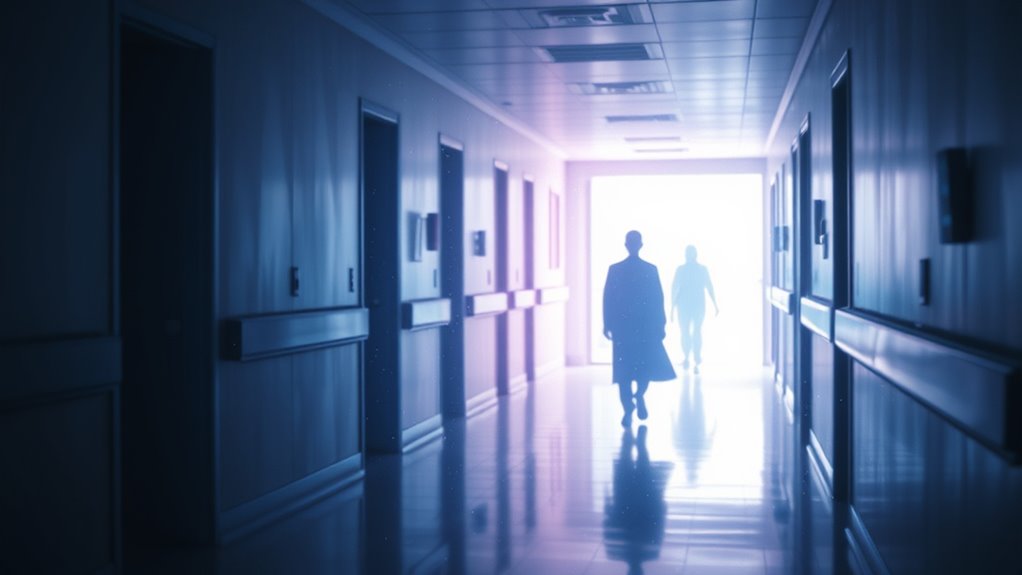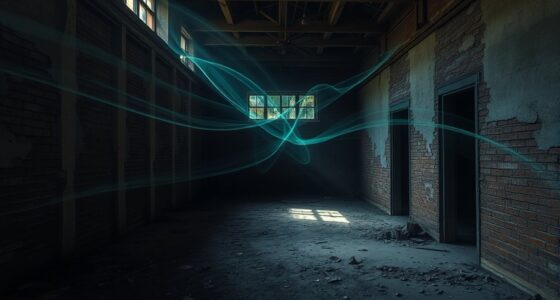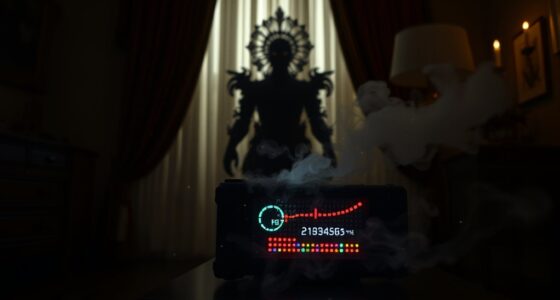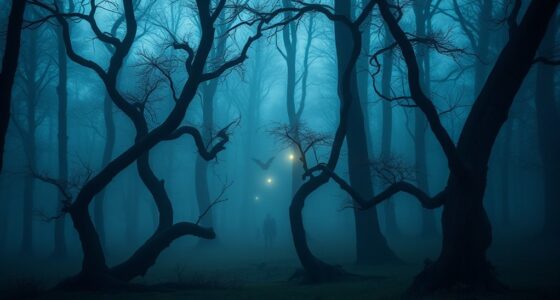Near-death experiences often include vivid visions, feelings of peace, and out-of-body sensations, which scientists believe result from brain chemistry changes, neural activity, or even quantum effects that connect consciousness to a deeper domain. Cultural beliefs shape how you interpret these visions, but research suggests some aspects might hint at consciousness lasting beyond physical death. If you’re curious about what science says regarding the afterlife, this overview offers insightful clues.
Key Takeaways
- Scientific research suggests NDEs involve brain chemistry changes, such as neurotransmitter fluctuations and neural activity, producing vivid, spiritual-like visions.
- Quantum theories propose consciousness may connect to a deeper reality, offering a glimpse of an afterlife beyond physical existence.
- Cultural beliefs influence how NDEs are perceived, with common elements like lights and tunnels interpreted as spiritual or divine encounters.
- Physiological responses like hypoxia and endorphin release can trigger sensory experiences that resemble glimpses into an afterlife.
- Evidence from AI and neuroscience indicates that consciousness might operate independently of the brain, hinting at the possibility of an afterlife.
The Phenomenon of Near-Death Experiences

Have you ever wondered what happens when someone comes close to death? Many researchers believe quantum consciousness plays a role in near-death experiences, connecting the mind to a deeper reality. During these moments, people often report vivid near-death memories that seem to transcend normal perception. These memories can include intense feelings of peace, visions, or perceptions of being outside their body. Some scientists suggest that quantum phenomena in the brain might facilitate this extraordinary shift, allowing consciousness to momentarily access a domain beyond physical existence. Recent studies exploring quantum brain processes propose that subtle quantum effects within neural structures could underpin these extraordinary experiences. Understanding this phenomenon challenges our ideas about life, death, and what lies beyond. As AI technologies advance, exploring neuroscientific theories may provide new insights into the nature of consciousness and near-death phenomena, bridging scientific inquiry with philosophical questions. Recent advancements in quantum biology also support the idea that quantum effects could play a crucial role in such profound experiences.
Common Elements Reported During NDEs

Many people who experience near-death experiences report a set of common elements that seem to transcend individual differences. These shared features create a vivid, almost surreal picture of what many encounter.
Near-death experiences often include shared, vivid visions that feel almost surreal.
- You might see phantom visions, such as luminous beings or moving lights that seem to guide or comfort you.
- You could perceive a glowing aura, an energy field surrounding objects or people, enhancing feelings of connection.
- Some report experiencing a detachment from their physical body, along with clear aura perceptions that reveal a heightened awareness of their surroundings. This phenomenon aligns with transcendence, suggesting a journey beyond the physical realm into a different state of consciousness. Additionally, some accounts describe the perception of a boundary or barrier, which may symbolize the transition between life and what lies beyond. Recognizing consciousness as a key element helps explain these vivid experiences reported during NDEs. Evidence from near-death studies supports the idea that consciousness can exist independently of the physical body, further reinforcing the significance of these perceptions. Furthermore, research indicates that altered states of consciousness experienced during NDEs may share similarities with other spiritual or mystical experiences, highlighting potential common mechanisms behind these phenomena.
Scientific Explanations and Theories

Scientists often explain near-death experiences through brain chemistry effects and physiological responses. You might consider how changes in brain activity or oxygen levels could produce vivid sensations. Exploring these explanations helps us understand NDEs from a scientific perspective. Additionally, some theories suggest that cell turnover and skin response mechanisms could influence sensory perceptions during these events. Recent research indicates that neurotransmitter fluctuations may also play a significant role in the vivid hallucinations reported during NDEs. Furthermore, understanding brain chemistry is crucial for comprehending the complex neural processes involved in these phenomena. Advances in AI—artificial intelligence are increasingly being used to analyze neural data, providing deeper insights into the neural correlates of consciousness during these experiences.
Brain Chemistry Effects
Brain chemistry effects are often cited as a scientific explanation for near-death experiences, as certain neurochemical processes can produce vivid sensations and altered perceptions. When your brain releases a surge of neurotransmitters, it can create feelings of euphoria, detachment, or hallucinations. Changes in brain wave patterns, such as increased gamma or theta waves, may also contribute to vivid visions or out-of-body sensations. To visualize this:
- Neurotransmitter release floods your brain with chemicals like dopamine and serotonin, heightening sensory experiences.
- Altered brain wave patterns produce dream-like states, blurring the line between reality and imagination.
- These chemical shifts can induce a sense of peace, floating, or encountering loved ones, mimicking spiritual or afterlife visions.
- The high contrast ratio of certain neurochemical effects can make these experiences seem incredibly vivid and real. Additionally, research suggests that these biochemical activities may be transient and reversible, which aligns with the temporary nature of many NDEs.
- Understanding the neurochemical pathways involved in these processes helps explain how such profound experiences can occur within the brain’s natural functioning. Moreover, studies of brain neuroplasticity indicate that these experiences may be shaped by pre-existing neural networks, adding another layer to understanding NDEs.
This biochemical activity offers a plausible scientific basis for many NDE phenomena.
Physiological Responses
When the body undergoes extreme stress or trauma, physiological responses can trigger near-death experiences by altering brain function and bodily sensations. During these moments, biological markers like changes in oxygen levels, carbon dioxide, and neurotransmitter release activate specific neural mechanisms. These responses can cause hallucinations, distorted perceptions, or vivid sensations that resemble spiritual visions. For instance, spikes in endorphins may dull pain while creating a sense of peace, and altered neural activity in areas responsible for awareness can produce out-of-body sensations. These physiological responses are the body’s natural way of coping with extreme stress, but they also provide a scientific basis for understanding some of the vivid, often transformative experiences reported during near-death episodes.
Neuroscience and the Brain’s Role in NDEs

Although near-death experiences (NDEs) have long intrigued both scientists and the public, recent research suggests that specific neural mechanisms might explain these vivid phenomena. In consciousness studies, researchers focus on how the brain generates extraordinary perceptions during NDEs. You can consider three key ideas:
- Disrupted brain activity in areas like the temporoparietal junction may create sensations of detachment or out-of-body experiences.
- Altered neurotransmitter levels, such as increased serotonin, might produce hallucinations or visual phenomena.
- Brain hypoxia or reduced oxygen supply could trigger vivid visual and auditory experiences, simulating a sense of moving toward an afterlife.
These neural mechanisms help explain the brain’s potential role in shaping NDEs, bringing scientific clarity to these profound experiences.
Cultural and Personal Interpretations

Your perception of near-death experiences is heavily influenced by cultural beliefs and personal backgrounds. These interpretations shape how individuals describe and understand their experiences, often reflecting their identity. Noticing similarities and differences across cultures can reveal how universal and varied these phenomena truly are.
Cultural Beliefs Shaped Perceptions
Cultural beliefs substantially influence how you interpret near-death experiences, shaping the meanings you assign to these profound events. Your background guides whether you see these experiences through spiritual interpretations or religious influences. For example:
- In some cultures, you might view a bright light as a divine presence or heavenly domain.
- Others may interpret encounters with loved ones as spirits guiding you toward the afterlife.
- Different traditions may see visions as symbolic or literal, depending on ingrained beliefs.
These perspectives frame how you process the experience, often reinforcing cultural narratives about death and the afterlife. Your cultural context plays a vital role in transforming a personal event into a meaningful spiritual or religious story, influencing future beliefs and attitudes toward mortality.
Personal Narratives and Identity
Personal narratives and individual identity shape how you interpret near-death experiences, adding unique layers of meaning based on your cultural background and personal beliefs. Your sense of memory continuity influences whether you see these experiences as genuine glimpses of an afterlife or vivid hallucinations. If your spiritual identity is strong, you might interpret these events as confirming your beliefs or revealing divine truths. Conversely, if you question spiritual concepts, you may view them as psychological processes or brain functions. Personal stories shape how you process sensations, visions, and emotions during NDEs, affecting your understanding of existence beyond physical death. Ultimately, your identity influences whether you see these experiences as transformative, comforting, or merely neurological phenomena.
Cross-Cultural Similarities and Differences
Near-death experiences often share striking similarities across different cultures, yet the interpretations and meanings attached to them can vary widely. You might see common elements like bright lights, tunnels, or feelings of peace, which reflect universal spiritual symbolism. However, cultural backgrounds influence how people interpret these visions. For example, some cultures see the tunnel as a journey toward divine judgment, while others view it as an ascent to ancestral domains. Ritual practices often shape these perceptions—certain ceremonies aim to prepare souls for the afterlife or interpret visions through spiritual symbolism. These differences highlight how personal and cultural beliefs shape the meaning of near-death experiences, blending shared human phenomena with diverse spiritual and ritual frameworks.
What Research Is Revealing About the Afterlife

Recent research into near-death experiences (NDEs) is shedding new light on the possibility of an afterlife. Scientists explore quantum consciousness to understand how consciousness might exist beyond physical death. Some evidence suggests that during NDEs, your brain may access a non-local, interconnected domain, hinting at a spiritual awakening. These experiences often involve feelings of peace, encounters with loved ones, or visions of a brighter realm, which many interpret as glimpses of an afterlife. Researchers are studying these phenomena to determine whether consciousness persists independently of the body. While definitive proof remains elusive, findings suggest that NDEs could be more than hallucinations—they might point to a reality beyond physical life, supporting the idea that consciousness continues after death.
Frequently Asked Questions
Can NDES Be Reliably Used as Evidence of an Afterlife?
You might wonder if NDEs can reliably prove an afterlife, but scientific skepticism remains. These experiences are often anecdotal, making their reliability questionable. While many report profound sensations, they don’t provide conclusive evidence, as brain activity can produce similar visions. So, you shouldn’t rely solely on NDEs as proof of an afterlife, since their anecdotal nature limits scientific validation and objective certainty.
How Do Cultural Beliefs Influence NDE Descriptions Worldwide?
Imagine a mirror reflecting different images based on the viewer’s cultural narratives and belief systems. Your perception of NDEs varies worldwide because these stories are shaped by cultural beliefs, shaping vivid descriptions like tunnels, angels, or spirits. Data shows that cultural context deeply influences how people interpret near-death experiences, reinforcing that belief systems act as lenses, coloring the way individuals perceive and describe these profound moments.
Are There Any Risks or Dangers Associated With Exploring NDE Phenomena?
When exploring NDE phenomena, you should be aware of potential psychological risks and spiritual dangers. You might experience emotional distress, anxiety, or confusion, especially if your beliefs or expectations clash with what you encounter. Engaging deeply without proper guidance can lead to psychological strain or spiritual disillusionment. To stay safe, approach these experiences cautiously, seek support if needed, and remain open-minded while protecting your mental and spiritual well-being.
What Role Do Personal Beliefs Play in the Interpretation of NDES?
Imagine you’re using a crystal ball in the 1800s—your personal biases and beliefs heavily influence what you see. Similarly, your belief influence shapes how you interpret NDEs; your background, culture, and faith color your understanding. Personal biases can distort or deepen your perception, making your experience unique. Recognizing this helps you differentiate between what’s influenced by your beliefs and what might be a genuine phenomenon.
Could Future Technology Definitively Prove or Disprove the Existence of an Afterlife?
You wonder if future technology could definitively prove or disprove the afterlife. While advances in quantum consciousness might reveal how consciousness interacts with the universe, achieving technological immortality could suggest a form of ongoing existence. However, proving or disproving an afterlife remains complex, as it challenges the very limits of science and perception. Ultimately, you may find that some mysteries stay beyond technological reach, shaped by what you believe.
Conclusion
As you explore near-death experiences, you see the mysteries they reveal, the questions they raise, and the truths they challenge. You wonder about the limits of science, the depths of consciousness, and the possibility of an afterlife. You seek answers in neuroscience, in culture, in personal stories. Ultimately, you realize that understanding NDEs invites you to ponder life, confront death, and embrace the profound unknown that awaits beyond.









